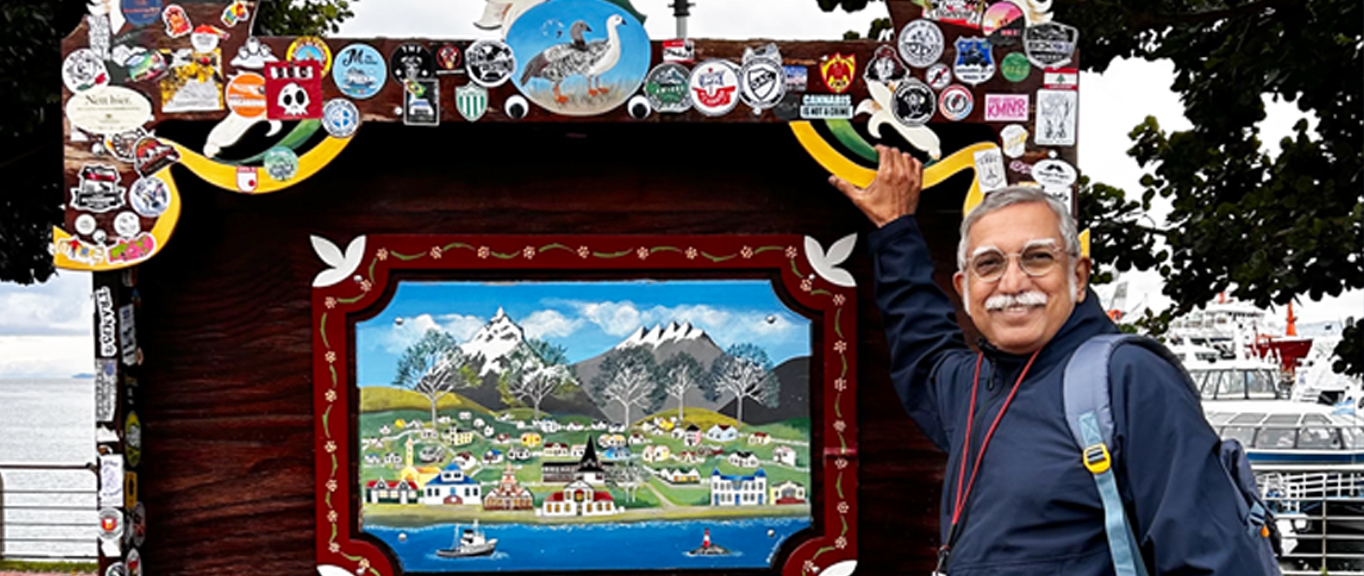Polar Pioneers: IITB Alumni, Raj Nair and Raj Melville, Explore Antarctica
In a remarkable convergence of fate and adventure, two of our alumni – Mr. Raj Nair and Dr. Raj Melville, recently embarked on separate journeys to the frozen continent of Antarctica. As if echoing the spirit of exploration that courses through our alma mater, Mr. Nair and Mr. Melville ventured into the icy heart of the southernmost reaches of our planet, each driven by their quest for discovery and enlightenment.
What makes this extraordinary tale even more captivating is that both of them have generously shared their experiences with us. Through a blend of vivid imagery and eloquent prose, they offer us a glimpse into the otherworldly landscapes, the breathtaking wildlife encounters, and the profound moments of introspection that defined their Antarctic expeditions.
We are delighted to present these two captivating narratives of Antarctic exploration, courtesy of our distinguished alumni. Immerse yourselves in the adventures of Mr. Raj Nair and Dr. Raj Melville, and embark on a journey that transcends the boundaries of geography to touch the very essence of human curiosity and resilience.
Raj Nair’s Visual Odyssey through Antarctica
In the vast expanse of human exploration, few frontiers captivate the imagination quite like Antarctica, the frozen continent at the bottom of the world. It’s a realm of extremes, where icy landscapes stretch as far as the eye can see, and the silence is punctuated only by the sounds of cracking ice and the calls of wildlife.
Recently, Mr. Raj Nair embarked on an extraordinary journey to this pristine wilderness. We are delighted to share his treasure trove of stunning images that capture the sublime beauty of Antarctica. As you enjoy these visual marvels, don’t forget to read the heartfelt letter he has penned to the icy continent itself, chronicling his adventures and reflections on the significance of his expedition.
Over to Mr. Nair:
All set to sail from the ‘end of the world’, Ushuaia across the Drake Passage to Antarctica.

The snow-topped Andes moving East-West at the Southern tip after running North-South across South America, before sinking Into the Atlantic Ocean

Before the crack of dawn, I was breathless when I spied the first sign of Antarctica.

Una Paloma Blanca: When the Sun shines over the mountains. Now I was definitely in Antarctica
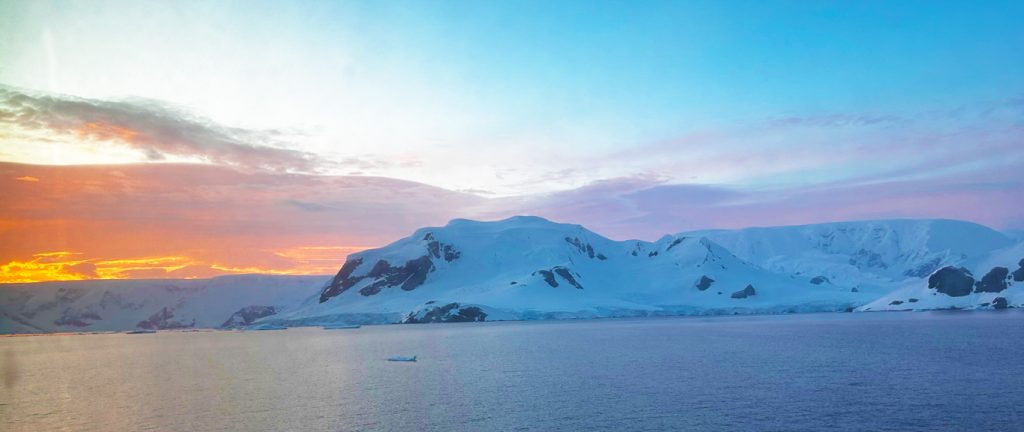
An hour later, welcome to its shores could not have been any warmer

A storm rolled in the next morning and we rode into it to see Antarctica in all its glory

The storm vanished as quickly as it came, and the waters became calm as a lake and Antarctica treated me to some amazing reflections

Wow! A submarine in Antarctic waters!

Oh God! Is the submarine sinking vertically?

Not at all, I am hungry Moby Dick

Flappy (above and feeding below) while Bro Noddy has already had his fill
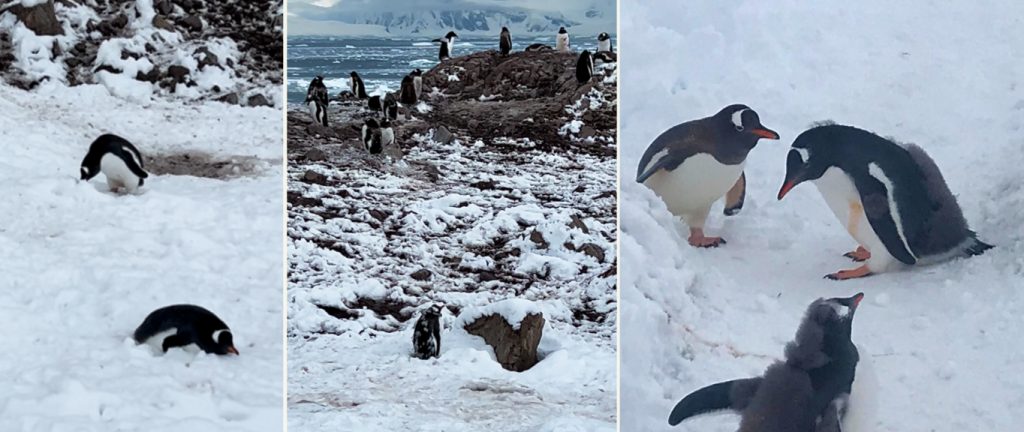
Their large family at their rookery
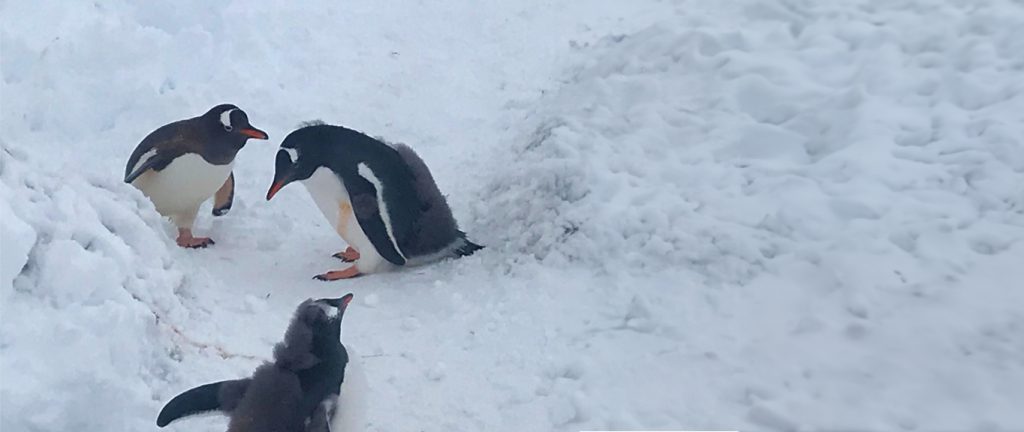
The court is in session: Judge Penguin with Lawyer Penguins
Life and Death go hand in hand here, like Sunny Days and Blistering Storms

Seals fighting ferociously and…
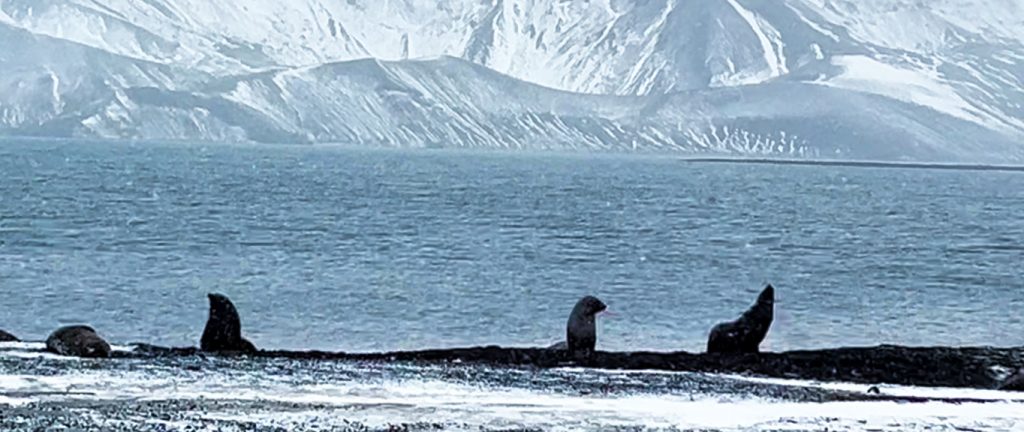
……in peace, moments later.
Deathly silence after storm. Time stands still. Old remains of a boat and a whale that once roamed in the icy waters.

That’s me…stunned, surprised, serene and, and wanting more at the end of the Antarctic expedition.

I am heading to the Arctic at the end of May. So it will be the North and the South in 90 days!
*********
Mr. Nair’s heartfelt letter to Antarctica:
Dear Antarctica,
I love surprises. So, I read as little as possible about you and details of the expedition documents before meeting you and only prepared myself for the extreme chilly weather and physical challenges. There was Decathlon for the former; a little exercise and a 10 km walk per day for the latter. Everything I imagined about you was wrong. I needed no fitness regime but I should have got better gloves. I didn’t even realise that you would let me choose my time zone because you don’t have any. Since the voyage was to start from and end in Argentina, it was logical to set my watch to Argentinian Standard time which is eight and a half hours behind the Indian Standard Time.
I thought of you as one huge flat desert of ice with blizzards blowing away any possibility of seeing things beyond one hundred metres. The latter could be correct in winter but I visited you in late Summer. The tall white and black mountains right next to water bodies totally zapped me. I wondered what blithe spirits, the ill-equipped adventurers of the yore were, to scale your tall mountains to go from your coastline to the South Pole.
Had I checked a map carefully, I would have noticed your long and muscular welcoming arm, stretching in the direction of the Southern tip of Argentina and Chile. Cartographers named it, the Antarctic Peninsula though, I imagine that it really looks like an arm if seen from an airplane, flying five thousand meters above. Your arm even has what might look like tiny hair-like land and ice protrusions into the Wendell Sea and the Bellinghausen Sea, a few pock marks left by volcanos of the past, many black beauty spots like rocky outcrops on your silky white arm which are visible only during summer when you take off your white winter overcoat and the undulating terrain look like muscles.
I sailed for two days and two nights from Ushuaia in Argentina across the Drake Passage (of the Drake Shake fame). I will refrain from writing about whether Chile or Argentina has the city closest to you because this piece is about you and not settling the banter between those neighbouring countries. I missed the tall 8 to 13-metre waves the Drake Passage is famous for. When I told the folks who set the course, that I didn’t sign up for two-metre waves, they confessed that they skirted a storm to avoid the huge waves. I suppose that what really drove them was less their concern people who could puke but more because ‘cleaning up is hard to do. The return voyage was as enjoyable as going to meet you, due to many friendships stuck over ten days and because on the last night, the Captain gave a brief taste of the Drake Shake with 4 to 6-metre waves rocking our well-built expedition cruise ship, Fridtjof Nantes- a hybrid power vessel commissioned in 2021. It provided all the human comfort, luxury, and safety one could ask for. It also helped me recoup after every daily onshore expedition. I appreciate the fact that all the lectures conducted by Hurtigruten, the expedition operator, started on the dot, not a minute early, not a minute late (as if they knew that I am a stickler for punctuality). That much for the voyage and now about you.
Fortunately, the first sight of you made up for the Captain’s disappointing decision to avoid huge waves. It was pre-dawn. Everything except my spirits seemed blue. First, there were big floating icebergs. Then there were snow-capped mountains at your distant shores- a huge surprise! The sun slowly crept over the mountains and without realising it, I silently hummed the song, Una Paloma Blanca. What a sight! I ran for my iPhone camera. By the time, the ship dropped anchor, a golden Sunrise warmly welcomed us. I should have expected mountains after seeing the tall snow-capped mountains at the tail end of the Andes in Ushuaia.
I should have realised that the Andes did not abruptly end at the tip of Chile and Argentina and would be just like the Arakan Yoma that stretches all the way from Myanmar, undersea to the Andamans & Nicobar and beyond, often peeping out of the sea in the form of islands. The Andes too, does have many islands and very tall undersea peaks. One of those islands was the scene of a battle during Mrs Thatcher’s time. The Andes have also created passages between islands near Ushuaia named after people whom I admire. Magellan and Charles Darwin earned their right but I dare say that naming the Passage between you and South America after Drake is a bit out of place. In 1578, the brave but intelligent Drake actually avoided this unruly sea where the Atlantic and Pacific Oceans meet. It should have been named, Hell’s Fury because it is the most dangerous sea in the world and has consumed eight thousand ships in recorded history.
During the lazy two-day voyage across the Drake Passage, the onboard team of an ornithologist, a whale expert, and oceanographers educated us about their own field of expertise as they relate to you and the seas around you. Even that did not prepare me for what I saw when my ship dropped anchor. I could not wait to jump onto a motorised rubber Zodiac to get onshore. Your terrain is more than challenging despite modern tools and gear. I wonder what manic willpower drove Amundsen, Scott, Shackleton, and others back in the day, to get to know you by going deep into your heart where the temperature is minus 80C. The South Pole, which is deep in your interior, is not a destination for faint hearts, but you are not forbidding at least, at the fringes.
Four layers of warm clothes with a parka over them, a woollen cap and a hood, waterproof over-pants, and polar boots (sophisticated gum boots) were okay but my gloves were inadequate to deal with the weather which you seem to easily handle a day in and day out. My misery was made worse because water got into my gloves while going onshore on day one. Lesson 1 is that one has to engineer one’s position in the queue for the Zodiac in such a way that one never has to sit at the front of the Zodiac. The boatman, who steers the boat from the back is always dry. Lesson 2 is not to ignore the hair dryer in the cabin just because one doesn’t need to dry one’s short hair. It can dry the insides of wet gloves in a jiffy. A few days later, it also helped to dry my shoes that got wet in the downpour in Buenos Aires on my way back.
An expert guide told me before we dropped anchor, “If you can describe Antarctica after your visit, you know nothing about it.” So, I will not describe you. I will stick to bits and pieces of what I experienced and let your mystery abide. I also hope this little travelogue does not encourage carefree and careless people to travel to meet you.
You nurture rare and fascinating creatures and scatter beautiful icebergs all around you. Who knew that you have birthed white, blue, green, and black icebergs including the world’s largest iceberg – the B15 which has an area of 11000 sq. km and is drifting on the Ross Ice Shelf! I now know that you are home to six types of whales. At this time of the year, your waterways are teeming with whales. They looked like mice on water when I peeped down from the airplane from Ushuaia to Buenos Aires. Ah, I believe that you are not host to a single mouse. That can change if you expand the scope of permitted overnight camping on certain small islands. It always starts in a small harmless manner, then will come temporary toilets which will give way to permanent mobile toilets and other baggage. That the South Pole is the only place where there is only one sunrise and one sunset in a year is enticing but expedition tourists cannot venture that far. I hope it remains that way, and no one ever decides to build a highway from your Coast to the South Pole. Please preserve your virginity.
I know that you reveal less than 1% of yourself to visitors so as not to make you too popular for your own good. But if I didn’t capture photographs and video clips, how would be able to convince myself in the years to come, that this visit was real and not one of my many nightly dreams? By the way, I am conscious that at my age, it is not unusual to confuse dreams with reality.
It might help keep irresponsible people away if I mention some challenges. I had to perforce remove my glove now and then to click pictures on my iPhone. That meant frozen fingers which hurt till I thawed them in hot water in my bathroom. Another inconvenient rule for conventional tourists is that humans can neither leave behind anything on your land or water nor take anything away from you. I confess that I pocketed a very small volcanic stone (no bigger than a pebble) and a bird’s broken beak but I did not dare to pee on you. That was more out of respect for you and your rules than for lack of facilities which would not have deterred me, as not many remote parts of India have facilities.
Thanks to my visit, I was able to see many types of fauna. It was fascinating to see three distinct types of penguins (Adele, Chinstrap, and Gentoo). If humans and penguins are on Penguin highways (burrows), penguins have the right of way. You have granted them numerous rights including the right to approach us (and when they do, we have to back off). Leopard seals and other types of seals like Fur seals and Elephant seals, enjoy similar rights. We are expected to know that they are carnivores. One Leopard seal kept circumambulating our Zodiac with a broad smile. The guide warned us that if we stretched our hands out, they would decamp with it. The whales ignored us for the most part as they prefer to eat krill because humans keep a safe distance, daunted by their size. Humpback Whales, Minke Whales, Sei Whales, Blue Whales (did not see one), and Orcas, all look like submarines traversing the seas around you. One such huge fellow, which was barely 150 feet away from our tiny, inflated Zodiac, suddenly rose nose up like a submarine that was torpedoed; it had just gulped lots of krill along with 20,000 litres of water in one swoop and was about to let the water out.
You have made sure that you are a safe haven for all creatures that live on you or visit you seasonally. You forced us to create an Antarctic Treaty System in 1959 which has sixty signatory countries now. It permits the use of Antarctica only for peaceful purposes, requires all scientific data gathered by each nation to be shared freely with other nations, and does not permit any country to claim any part of you as part of their sovereign domain. You are unique in that respect. A huge continent that had no ‘occupant’ countries, no settlers making it their own over time, no visa stamp on arrival and departure but strict protocol to control the number of visitors with a record of name, etc. The maximum number of scientists (and associated persons) living on you is about five thousand during summer, shrinking to about 1200 in winter. After COVID-19, casual visitors coming on expedition cruises cannot visit any scientific research stations. We try to protect you like no other part of the earth. We are not allowed to land without completely disinfecting our polar boots and our external clothing. Despite that some bacteria and viruses have been transported to you by birds. Bird flu H5N1 is raging now in the Arctic and some dead birds have been found even on you recently. Therefore, we are not even allowed to sit on you to rest our tired bones.
Despite all these curbs and challenges, visiting you is a once-in-a-lifetime experience that no able-bodied responsible person should forego. Your tall sheer mountains positioned next to waterways which reflect them in all their glory will make the Alps and the Himalayas envious. The seas around you command rapt attention due to whales surfacing suddenly like submarines, penguins prancing on and just below the waters, moving like mini dolphins, seals hunting them, gulls … and albatrosses diving to catch fish, etc. When all this marine activity and your snow-clad mountains are juxtaposed, the scenery is surreal. The Sun rising from behind the mountains adds to the glory. That’s why more people like me will keep coming to see you despite the rain, cloudy skies, snow, and howling winds which make the snow bite the skin. You spared me your famed dust-laden storms which, I am told, really hurt, and make ships sway violently. Since you also did not permit me to trek far on your body, not even to visit Scientific Stations (post-Covid-19), I was not exposed to loneliness, the uncertainty of what lay ahead, depression, etc. Instead, I was assured of the safe return to the mother ship after each expedition trip besides warm soup, freshly cooked food, and good wine to ease the morsels down. This probably made you less forbidding than I imagined.
One of the highlights of the trip was the team of ornithologists, whale researchers, geologists, marine biologists, etc. who held several knowledge sessions for us. What a waste of a day, if one does not learn something new through observation of things around us, or by listening to experts or by reading! There was something that I did not know earlier at every turn; even the name of the ship- Fridtjof Nansen. I found only later that he was a Norwegian Polymath and Arctic explorer who won the Nobel Peace Prize in 1922 for the amazing humanitarian services rendered to displaced people around the World. He led many expeditions in the Arctic in the late 19th century and made huge scientific contributions to zoology and oceanography. He played a key role in securing independence for Norway from Sweden and was the first High Commissioner for Refugees at the League of Nations. The Antarctic expedition cruise was so good and the story of Fridtjof Nantes was so inspiring, that I signed up to go to the Arctic at the end of May. The thought of traveling from the Southernmost township in the world (Ushuaia) to the Northernmost township in the World (Longyearbyen) within 90 days was a tempting proposition. Travelling more than 1000 km South of Ushuaia was even more exciting. Time will tell how much further North of Longyearbyen I can go. It all depends upon the expedition ship, Fram which I have booked. It so happens that Fridtjof Nansen used a specially designed ice cutter ship named Fram, for his Arctic Expeditions from 1893 to 1896 when Fram drifted on close to the North Pole (86 deg 14min North). Who can tell where my Fram will take me?
With Love, Awe, and Respect,
Yours truly,
Raj Nair

